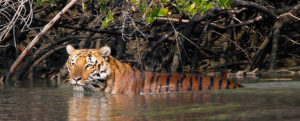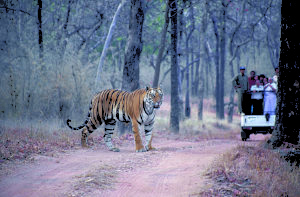International Tiger Day: Five must visit Tiger Reserves in India
Home to world’s largest population of tigers, India offers amazing wildlife safari experiences where one is sure to come face to face with the most ferocious occupant of the jungle. Here are five tiger reserves worth a visit.
July 29 marks International Tiger Day, aimed at raising awareness about the need for tiger conservation and promoting a global system to protect the natural habitats of tigers. Launched in 2010 at the Saint Petersburg Tiger Summit in Russia due the falling numbers tigers in the world, this day has since been used to remind people about the importance of tigers and to generate popular support for tiger conservation issues.
As per Status of Tigers, Co-Predators & Prey in India report released on July 29 by union minister for environment, forests and climate change Prakash Javadekar, the total population of the big cats in India stands at 2,967 now from a mere 268 in 1973 when Project Tiger, touted as the world’s most successful conservation programme, began. The report says that India has a total of 50 tiger reserves spread all over the country. The biggest habitat is the Jim Corbett national park in Uttarakhand that currently has 231 tigers, a steady rise from 215 in 2014.
“India is proud of its tiger assets. The country today has 70 pc of the world’s tiger population. We are ready to work with all the 13 tiger range countries in their actual management of tiger reserves,’’ Javadekar said while speaking at a function at the National Media Centre, New Delhi.
‘‘At the international level, we have a lot of soft powers, but one soft power is that the country has animals. India has 30,000 elephants 3,000 one-horned rhinos and more than 500 lions,’’ he added.
Despite the rise in number of tigers, there have been numerous incidents of poaching that has gone on undeterred despite use of technology to protect wildlife parks and increase in number of wardens. In the five years from 2015-19, a total of 186 tigers were poached in India, says Poaching Facts, an NGO based in the United States.
Also, some experts doubt the statistics put out by the government as they question the accuracy of the tiger surveys saying there are high risks of double counting and counting methods need to be improved in order to be more accurate.
But tiger sightings are becoming more common in many national parks, pointing to a growth in population. There has also been a corresponding rise in tourists’ interest in exploring these natural gems. While earlier wildlife tourism in India was dominated by foreign tourists, the last decade has seen a sharp spike in Indian tourists visiting wildlife sanctuaries.
The growth is likely to continue once the coronavirus pandemic subsides in India. Already, in preparation, companies like Thomas Cook and SOTC have launched special post-pandemic tours to India’s wildlife reserves. ‘‘People nowadays prefer unconventional travelling. With the pressures of lockdown, customers have shown a strong sentiment towards travelling once the lockdown is lifted and are waiting eagerly to be outdoors. Gen Z and the millennials show strong inclination to explore adventure and nature-based holidays with their families. We see strong interest from honeymoon couples who wish to experience the thrill of wildlife holidays. Outdoors activities such as nature camps, national parks and hiking trails are popular among those travelling with friends, families and nature lovers,’’ Daniel Dsouza, president and country head, Leisure at SOTC Travel tells Media India Group.
The travel firms believe that the government should provide incentives for promotion of wildlife tourism and also put in place structured training courses and certifications for naturalists and guides. ‘‘Wildlife tourism provides a huge opportunity to create awareness and respect for India’s spectacular wildlife and their natural habitats. While educating people about the country’s rich bio-diversity is of utmost importance, other measures to facilitate wildlife tourism in India include providing tax rebates or subsidy to hotels setting up properties that respect the ecosystem and tour operators promoting wild life tours. The government should also launch accredited certification and training programmes for naturalists and guides,’’ Rajeev Kale, president & country head, Holidays, Mice and Visa at Thomas Cook India, the country’s largest travel company, tells Media India Group.
‘‘The government should also create more protected areas for endangered species and take strong and visible deterrents against poaching. It should also review its conservation policies as well as make budgetary allocation for creation and promotion of new wildlife circuits,’’ adds Kale.
Tigers are now found in 18 states of the country, with Madhya Pradesh topping the list with 526 tigers, followed closely by Karnataka (524), Uttarakhand (442), Maharashtra (312) and Tamil Nadu (264). We bring here five sanctuaries that one must visit to get see India’s National Animal in different habitats.

Jim Corbett National Park has the highest tiger population in the country (Credit: rohit Varma/flickr)
Jim Corbett National Park, Uttarakhand
Nestled in the foothills of the Himalayas, the Jim Corbett National Park is one of the country’s oldest parks, first established in 1936 as the Hailey National Park. In the mid-1950s, the park was dedicated to the legendary hunter-turned-conservationist Jim Corbett.
The 520 square kilometres of Corbett comprises of hills, marshy depressions, riverine belts, grasslands and large lakes. In addition to tigers, one can leopards, jungle cats, fishing cats, sloth bears, jackals, Bharal, goral, Himalayan tahr, serow, chital, sambal and barking deer.
Nature watch and wildlife viewing in the park is done with various safaris like, jeep safaris, elephant safari and Canter safari. Dhikala, situated at the border of the extensive Patil Dun valley, is the most popular destination in Corbett because of its superb location and sheer abundance of wildlife. It also has watchtowers where one can spend hours observing the wildlife.
Corbett National Park is among the few tiger reserves in India that allows overnight stays in the lap of the National Park. Tourists can stay in the safari tents, jungle cottages and lodges to have one of a kind experience.
Best time to visit: October to June
Bandhavgarh National Park, Madhya Pradesh
Bandhavgarh National Park, is located in the Vindhya Hills of the Umaria district in Madhya Pradesh. Spread across the core area of 105 square km, the park consists of mixed vegetation ranging from tall grasslands to thick Sal forest and is the perfect habitat of variety of animals and birds. Due to varied topography, the Bandhavgarh National Park provides ample opportunity to spot the majestic Indian tiger and some other rarely seen animals like leopard and sloth bear. Due to high wildlife sighting it has been very popular amongst tourists, foreign as well as Indian.
Curiously, the park is also known as the land of the white tiger, even though white tigers no longer exist here. The last white tiger spotted in the wild was captured here by Maharaja Martand Singh of Rewa in 1951. The park has been divided into three major zones named as Tala, Magdi and Bamera out of which the Tala zone attracts most of the tourists due to good tiger sighting opportunities.
Best time to visit: February-June

Along with the forts and palaces of Rajasthan, the Ranthambore National Park is a must on a tourist’s itinerary (Credit: ranthamborenationalpark.com)
Ranthambore National Park, Rajasthan
One of India’s largest national parks at 1,334 sqkm, the Ranthambore National Park is located at the junction of the Aravali and Vindhya hill ranges in Rajasthan, making it one of the finest places to view wild animals.
One of the most renowned national parks in the country, Ranthambore is a major wildlife tourist attraction that has also drawn the attention of many wildlife photographers and animal lovers, besides tourists from the worldover.
The park was earlier used as a hunting grounds of the Maharajas of Jaipur and gained popularity in 1960s after British Prince Philip shot a tiger here during Queen Elizabeth II’s visit to India. The park introduced protection for tigers from hunters in 1973 and is now one of the best tiger reserves in India.
The beauty of the park lies in the ruins of ancient era, the fort, after which the park is named. There are numerous water bodies scattered all across the park, which provide perfect relief to the wild animals during the scorching hot days in summers. Apart from tigers, the park is also home to leopards, jungle cats, sloth bears, hyenas, Indian foxes, jackals and crocodiles.
Best time to visit: October to June

With its Royal Bengal Tiger, the largest of the tigers and mangroves, Sundarban offers a unique wildlife experience (Credit: sunderbannationalpark.in)
Sundarban National Park, West Bengal
Set in the world’s largest mangrove forest, in the delta of the mighty Brahmaputra and Ganga, the Sundarban National Park, located in Sundarbans delta, in West Bengal, is worth a visit for several reasons. First it is a rare National Park to be classified as a World Heritage Site and second it is the only natural home of the Royal Bengal Tiger, the largest amongst the sub-species of tigers.
Spread over an area of about 1500 sqkm, the national park offers the unique experience of a safari on a small boat that criss-crosses the mangroves, with the tigers possibly hiding on any tree above, providing perhaps the closest encounter possible with the ferocious big cat in the wild. The Sundarban National Park also has other attractions for the wildlife lovers, notably macaques, Indian Grey mongoose, leopard cats, Ridley Sea Turtle, wild boar, jungle cat, fox, flying fox, fishing cats, chital, pangolin and a lot more.
Best time to visit: September-May

Set in the Nilgiris biosphere, Bandipur is the largest tiger reserve in South India (Credit: bandipurtigerreserve.in)
Bandipur National Park, Karnataka
The Bandipur Tiger Reserve in southern state of Karnataka is one of the most important habitats for the tiger. Situated in two districts of Chamarajanagar and Mysore and adjoining Nagarahole, Mudumalai and Wayanad, Bandipur, which measures around 1,000 sq km in area forms a large chunk of the Nilgiri Biosphere Reserve. It is also part of the Western Ghats, recognised by UNESCO as one of the world’s eight ‘hottest hotspots’ of biological diversity. The Bandipur National Park is situated at the confluence of Western and Eastern Ghats and serves as a vital corridor for the seasonal migration of elephants from Mudumalai Sanctuary and Satyamangalam forest in the east and south east to Nagarahole National Park and Waynad Sanctuary in the west and north west. It supports a very high density of elephant population with significant number of adult tuskers.
The tiger reserve, which was a former hunting ground for the then royal family of Mysore, was called Venugopala Wildlife Park in 1941 and eventually, in 1973, when Project Tiger was launched it was renamed Bandipur National Park. The tiger population here has flourished over the years and offers one of the best chances of sighting the majestic creature in all its splendour and glory. Besides the tiger, Bandipur is also noted for its seven large ungulate species muntjac (barking deer), chital (spotted deer), sambhar, chousingha (four horned antelope), gaur, wild boar and elephant and three large predatory carnivores – tiger, leopard and dholes, the Indian wild dogs.
Best time to visit: March -May











